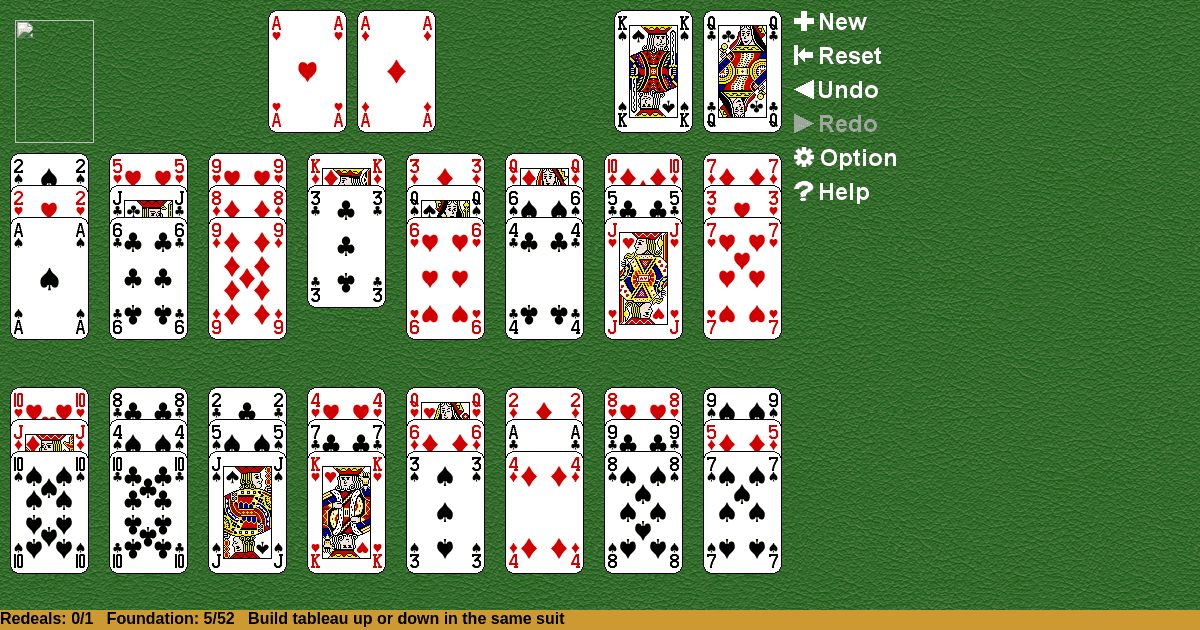Alternative
Home |
How to play |
FAQ |
About
How to play Alternative?
Game Objective:
The primary goal in Alternative Solitaire is to move all cards from the tableau and any other play areas to the foundation piles, arranging each foundation in a complete sequence according to the variant’s unique building rules until the deck is fully organized into foundations.
Setup & Layout:
- Deck: Use a standard 52-card deck.
- Foundations: Four foundation piles, one for each suit, are placed at the top. Foundations are typically started with the aces, but in some variants, both aces and kings may serve as foundation bases.
- Tableau: Cards are arranged into multiple columns (the number may vary by variant; a common setup is seven columns as in Klondike, or eight as in FreeCell).
- In some variants, all tableau cards are dealt face-up (as in FreeCell), while in others, only the top card of each column is face-up and the rest are face-down (as in Klondike).
- Stock: The remaining undealt cards form the stock pile, placed face-down.
- Waste: Cards drawn from the stock but not immediately playable are placed face-up in a waste pile.
- Reserve/Cells (if applicable): Some variants include reserve piles or free cells for temporary card storage.
Key Play Areas Defined:
- Tableau: The main area with columns of cards where most movement and sequence-building occurs.
- Foundations: The target piles where cards are built up (or down) by suit.
- Stock: The draw pile for introducing new cards into play.
- Waste: A holding area for cards drawn from the stock.
- Reserve/Cells: Optional areas for holding single cards temporarily.
Alternative Solitaire Rules:
- Card Movement:
- Only the top (exposed) card of each tableau column is available for play, unless moving a sequence is permitted by the rules.
- Cards may be moved between tableau columns, to the foundations, or to/from reserve/cell spaces if present.
- Building Sequences:
- On Tableau: Sequences are typically built down by alternating colors (e.g., red on black, black on red), or by suit, depending on the variant.
- On Foundations: Cards are built up by suit, usually starting from ace to king. In some variants, kings can also start a foundation and are built down by suit.
- Moving Cards/Sequences:
- Single cards or valid sequences can be moved between tableau columns if they follow the building rules (e.g., a red 6 on a black 7).
- In some variants, only one card may be moved at a time; in others, entire sequences may be moved if they are in correct order and color/suit alternation.
- Moving cards to reserve/cells is limited by the number of available spaces.
- Empty Spaces:
- Tableau spaces emptied by moving cards may be filled only by specific cards (e.g., only kings), or by any card, depending on the variant.
Gameplay:
- Turn Sequence:
- Move available cards between tableau columns or to the foundations, following the building rules.
- Draw cards from the stock pile when no further moves are available on the tableau. Place drawn cards onto the waste pile if not immediately playable.
- Play the top card of the waste pile to the tableau or foundations if possible.
- If reserve/cell spaces exist, use them strategically to temporarily store and free up cards.
- Introducing New Cards:
- Draw one card at a time from the stock to the waste pile. In some variants, multiple cards may be drawn at once.
- Only the top card of the waste pile is available for play.
- No More Moves:
- When no legal moves remain and the stock is exhausted, the game ends. In some variants, the waste pile may be reshuffled into a new stock once or a limited number of times.
Winning & Losing Conditions:
- Win Condition:
- The game is won when all cards are successfully moved to the foundation piles in the correct sequence (usually ace to king by suit, or as defined by the variant).
- Loss/Unwinnable Condition:
- The game is lost if no legal moves remain and the stock (and any allowed redeals) is exhausted, with cards still left in the tableau or other play areas.
Special Rules & Edge Cases:
- Filling Empty Spaces:
- In some variants, only a king (or a sequence starting with a king) may fill an empty tableau column.
- In others, any card or sequence may fill empty spaces.
- Multiple Foundations (Aces & Kings):
- Some variants allow both aces and kings to serve as foundation bases, with aces building up by suit and kings building down by suit.
- If a king is released, it may be placed above its corresponding ace foundation to start a new foundation built down by suit.
- Redeals:
- Some variants allow the waste pile to be reshuffled into the stock for one additional pass through the deck.
- Sequence Movement Limits:
- The number of cards that can be moved as a sequence may be limited by the number of empty reserve/cell spaces.
- Suit Rotation (Rare Variants):
- In certain rare variants, building may require following a specific rotation of suits rather than alternating colors.
This guide is based on the most common rules and unique mechanics described for "Alternative Solitaire" and closely related variants. For precise play, always refer to the specific ruleset provided with your chosen variant.

Solitaire Collection
About Alternative
Rate (Alternative)
4.7 / 5
1,916 votes



























































